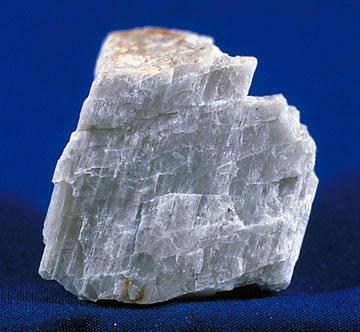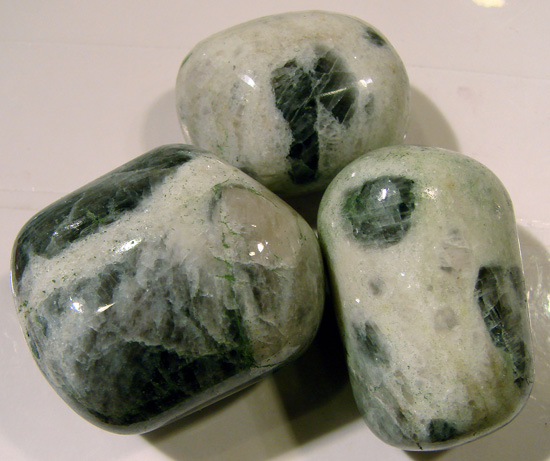Plagioclase
Plagioclase is a "solid solution series" of minerals in the feldspar family. Plagioclase feldspars are a "blend" of albite (sodium aluminium silicate) and anorthite (calcium aluminium silicate). They range all the way from pure albite (NaAlSi3O8) to pure anorthite (CaAl2Si2O8). Looked at another way, a plagioclase feldspar is an x aluminiosilicate, where x can be pure sodium, pure calcium, or a varied blend of the two. [1]

Plagioclase
Different ratios of sodium and calcium in the composition of the rock will result in the mineral being differentiated as one of the named "members" of the solid solution series: The plagioclase series of minerals has several named members: albite (100-90% albite and 0-10% anorthite), oligoclase (90-70% albite and 10-30% anorthite), andesine (70-50% albite and 30-50% anorthite), labradorite (50-30% albite and 50-70% anorthite), bytownite (30-10% albite and 70-90% anorthite) and anorthite (10-0% albite and 100-90% anorthite). [1] Moonstone is also partly plagioclase, being composed of fine layers of albite and orthoclase.
The name plagioclase derives from the Greek for "oblique fracture" and this refers to the fact that plagioclase has two distinct planes along which it cleaves - as can be seen in the picture. Plagioclase minerals have a hardness of around 6 (Mohs). [1] One of the identiying features of plagioclase crystals is a crystal twinning phenomenon calledpolysynthetic twinning - multiple crystals with fine striations looking like record grooves, aligned in the same direction.
Plagioclase History
Plagioclase was demonstrated b Johann F. C. Hessel (1796–1872) to be composed of solid solutions of albite and anorthite in 1826, [3] however the term plagioclase does not come into common use until the 1860's. The earliest mention of the term I found using Google book search is from the Geological Survey of Canada's 1862 Descriptive Catalogue of a Collection of the Economic Minerals of Canada. [4]
Plagioclase minerals are widespread in the world and make up a significant proportion of the earth's crust - but with the exception of albite and oligoclase, it is somewhat uncommon to see plagioclase minerals in crystalline form. [5] Plagioclase is used industrially in the manufacture of ceramics and glass. [6] However, transparent crystals of the various types are sometimes found and fashioned into gemstones - but you will usually see these by their individual names i.e. (andesine, bytownite, labradorite etc.) rather than labeled as a plagioclase gem.[7]
Plagioclase feldspars have also been found on the moon - and were in rocks brought back from the moon by Apollo 16 in 1972. [8]

Polished plagioclase pebbles
Plagioclase - Sources Referenced:
[1] http://en.wikipedia.org/wiki/Plagioclase
[2] http://en.wikipedia.org/wiki/Crystal_twinning
[3] http://en.wikipedia.org/wiki/Johann_F._C._Hessel
[4] http://books.google.com/books?id=laF9AAAAIAAJ&pg=PA188
[5] http://www.minerals.net/mineral/silicate/tecto/feldspar/plagiocl.htm
[6] http://www.britannica.com/EBchecked/topic/462644/plagioclase
[7] http://www.realgems.org/list_of_gemstones/feldspar.html
[8] http://commons.wikimedia.org/wiki/File:Lunar_Ferroan_Anorthosite_60025.jpg
Back to the Gemstones List home page - over 160 gemstones explored!
Please feel free to link to this page - copy / paste the text below: (click to select)
Privacy Policy | Cookie Policy | GDPR | About This Site / Terms

© gemstoneslist.com


